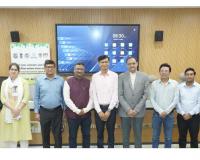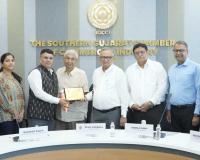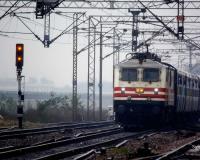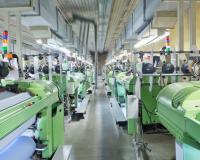Indian and Japanese ministers review progress of bullet train project at Surat site

Surat. Union Railways Minister Ashwini Vaishnaw and Japan’s Transport Minister Hiromasa Nakano visited the high-speed rail construction site in Surat on Friday to review the progress of India’s upcoming bullet train project. The ministers inspected key components of the project, including the track slab laying car and track slab adjustment facility, as part of a comprehensive on-site assessment.
As per agency report, the Ministry of Railways stated that the visit highlights the strong partnership between India and Japan in implementing the country’s first high-speed rail corridor. Both ministers expressed satisfaction with the quality standards being followed and praised the rapid pace of construction work. The National High Speed Rail Corporation Limited (NHSRCL), which is executing the project, said that the 508-kilometre Mumbai–Ahmedabad High Speed Rail Corridor will provide swift connectivity between Maharashtra and Gujarat.
An NHSRCL official explained that once operational, the high-speed train will run at a speed of 320 km per hour, starting from the Bandra-Kurla Complex (BKC) in Maharashtra and transforming intercity travel across Mumbai, Vapi, Surat, Anand, Vadodara, and Ahmedabad. The route will also connect industrial towns like Boisar, Bharuch, and Ankleshwar, as well as the upcoming Vadhavan Port via Boisar station. The train will halt at ten stations along the way—Thane, Virar, Boisar, Vapi, Bilimora, Surat, Bharuch, Vadodara, Anand, and Ahmedabad—with Sabarmati serving as the final stop. The journey between Mumbai and Ahmedabad, with limited stops at Surat, Vadodara, and Ahmedabad, will take approximately two hours and seven minutes, significantly reducing travel time compared to conventional trains or road travel.
Railway Minister Vaishnaw stated that the entire bullet train project is expected to be completed by the end of 2029. After inspecting the site, both ministers expressed deep satisfaction with the quality and speed of the work, indicating that the project is on track to meet its timeline. The visit further strengthens the close cooperation between India and Japan, with Japanese Shinkansen technology and expertise playing a crucial role in the project’s progress. It reaffirms both countries’ commitment to completing the corridor to world-class standards, marking a major transformation in India’s transportation landscape.
After arriving in Surat by air, Minister Hiromasa Nakano, along with Minister Vaishnaw, traveled on the Vande Bharat Express, where he was also briefed on the work underway inside the train. The NHSRCL had earlier issued tenders for signaling systems on the corridor to enable Vande Bharat trains to run at speeds of up to 280 km per hour. These trains are being developed as India’s indigenous high-speed alternatives. While the deal to purchase Japanese Shinkansen trains has been delayed, the ministry’s decision allows Vande Bharat trains to operate on the corridor until the Shinkansen sets arrive, ensuring the early operationalization of the high-speed network.






